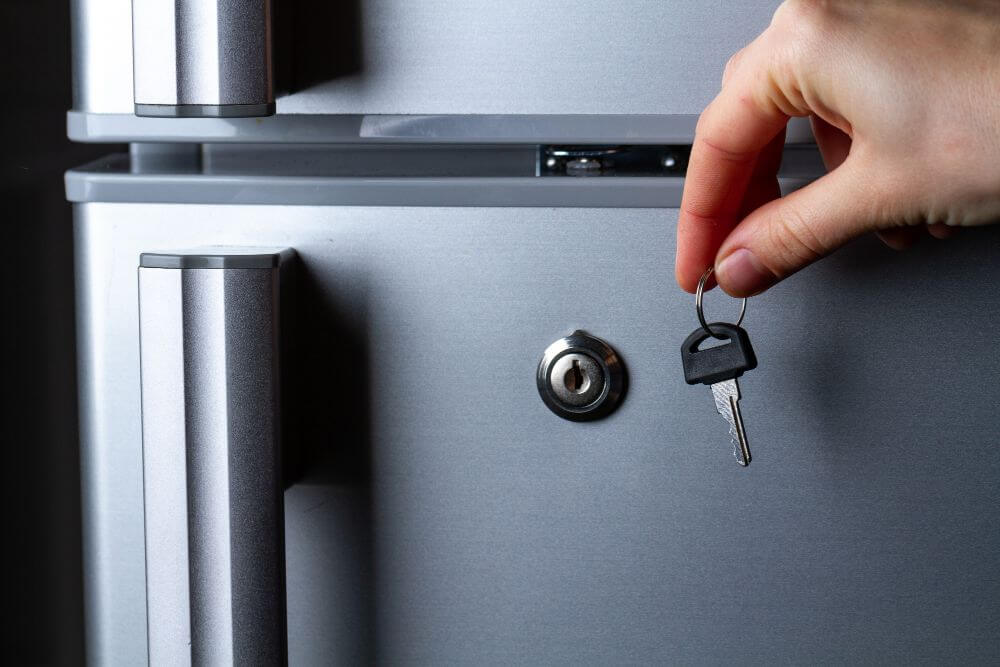You can use a few things to lock the refrigerator, depending on what you have available. A rubber band stretched around the handles is one option. You could also use a length of string or rope. If you have a spare key, you can put it in the lock and turn it so it can’t be turned back.
This blog post will cover everything you need to know about locking your refrigerator to keep your food safe. Without further ado, let’s get started!

Why is it Necessary to Lock the Refrigerator?
There are a few reasons why you might need to lock the refrigerator. Following are some common scenarios:
Small children in the house
If you have small children in the house, it’s important to lock the refrigerator to keep them from getting into it. Children can easily climb on furniture and reach the handles of the fridge. Once they know how to open the fridge, they can help themselves to whatever is inside.
Pets in the house
You’ll also want to lock the refrigerator if you have pets in the house. Pets are curious creatures and can easily open the fridge if they can reach the handles.
Food allergies in the house
If there are food allergies in the house, it’s important to keep the refrigerator locked. This way, people with allergies can’t accidentally eat something that will make them sick.
You’re having a party
If you’re having a party, you might want to lock the refrigerator to prevent your guests from helping themselves with your food.
You’re going on a vacation
If you’re going on vacation, you might want to lock the refrigerator so that the people in your home don’t have access to your food.
Sharing common space with others
If you share a common space with others, such as a dorm room or an apartment, you might want to lock the refrigerator to keep people from taking your food without permission.
These are just a few reasons you might need to lock the refrigerator. No matter your reason, it’s important to ensure that the fridge is locked so that no one can get into it.

Different Types of the Fridge Locks
Now that you know why it’s necessary to lock the refrigerator let’s look at the types of refrigerator locks you can use.
Button Strap Lock
One type of lock you can use is a button strap lock. This kind of lock has a strap that goes around the handles of the fridge. You push a button in the middle of the strap to secure it. To release the lock, you just push the button again.
Button strap locks are easy to use and are great for families with small children. They’re also relatively inexpensive, so you can buy a few of them to use around the house.
Slide Latch Lock
Another type of lock you can use is a slide latch lock. This kind of lock has a latch that slides over the handles of the fridge. To secure the lock, you push the latch down to flush with the handle. To release the lock, you just pull up on the latch.
Slide latch locks are a budget-friendly and simple solution for families with young children. They can be used around the fridge with multiple doors.
Padlock
If you want a more secure option, you can use a padlock. This kind of lock goes through the handles of the fridge. To secure the lock, you push the shackle through the hole in the handle and then close it. To release the lock, you just open the shackle.
Padlocks are great for people who want a more secure option. They’re also great for people with multiple fridge doors because you can put the padlock through all the handles.
Clip Starp Lock
The type of lock you can use is a clip strap lock. This kind of lock has a strap that clips around the handles of the fridge. To secure the lock, you push the clip down to flush with the handle. To release the lock, you just pull up on the clip.
Not only are clip strap locks simple and easy to use, but they’re also great for people with multiple fridge doors. You can easily clip the strap around all the handles, making it a breeze to keep your refrigerator doors shut and locked tight.

How to Install a Refrigerator Lock?
Once you decide which type of lock you want to use, it’s time to install it. The installation process will vary depending on the type of lock you choose.
Clean the Fridge Surface
The first step is to clean the fridge’s surface where you’ll install the lock. Use a damp cloth to wipe down the area. This will help ensure that the lock adheres properly. A dirty surface can prevent the lock from sticking or cause it to fall off.
Apply the Lock Hinges
The next step is to apply the lock hinges. This will be done on the fridge surface for the button strap and clip strap locks. Place the hinge on the surface and then press it down. The adhesive on the back of the hinge will adhere to the fridge. Repeat this process for the other side of the lock.
You’ll need to place the hinge inside the fridge door for the padlock. Place the hinge on the surface and then press it down. The adhesive on the back of the hinge will adhere to the fridge door. Repeat this process for the other side of the lock.
Attach the Lock Body
The next step is to attach the lock body. This will be done on the fridge surface for the button strap and clip strap locks. Place the lock’s body over the hinge and then press it down. The adhesive on the back of the body will adhere to the fridge. You’ll need to place the lock’s body inside the fridge door for the padlock. Place the body over the hinge and then press it down. The adhesive on the back of the body will adhere to the fridge door.
Install the Lock
The step is to install the lock. This simply means attaching the strap to the lock’s body for the button strap and clip strap locks. This means attaching the shackle to the lock’s body for the padlock.
Test the Lock
The final step is to test the lock. This simply means opening the fridge door to ensure the lock is working properly.
Final Words: What Can I Use to Lock the Refrigerator?
Now that you know how to lock a refrigerator, it’s time to put that knowledge into practice. Choose the type of lock you want to use, and then follow the installation steps. With a little effort, you’ll have your fridge locked up tight.





